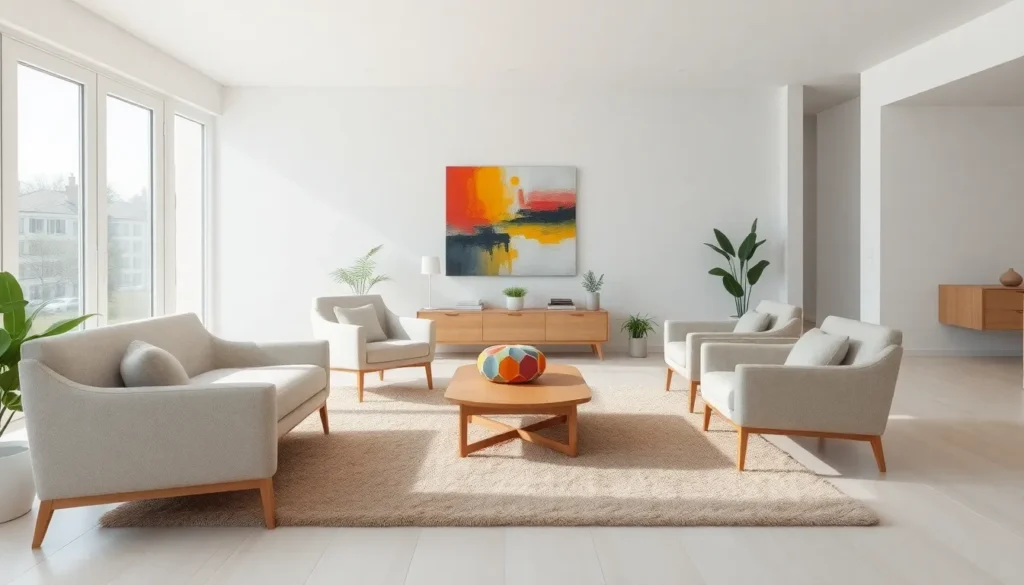Table of Contents
ToggleEver thought about living room designs that don’t require a sofa? You’re not alone. Many are diving headfirst into the minimalist trend, transforming cozy spaces into stylish sanctuaries without the bulk of traditional furniture. In a world where less truly is more, creating a sofa-free living room can be both liberating and visually appealing, think open spaces and a breath of fresh air. So, let’s explore how a sofa-free living room can spark joy and redefine your home.
Understanding Minimalist Living

Minimalist living is so much more than just a catchphrase: it’s a lifestyle that emphasizes simplicity, functionality, and intentionality. It involves stripping away excess to create a space that radiates calmness and clarity.
Key Principles of Minimalism
The foundation of minimalist design includes key principles such as:
- Less is More: Focus on the essentials, choosing items that are functional yet beautiful.
- Quality over Quantity: Invest in fewer pieces that hold meaning or serve a significant purpose.
- Open Spaces: Embrace emptiness and avoid clutter. The idea is to let your eyes wander freely, promoting a sense of peace.
- Natural Light: Maximize the use of windows to allow sunlight to flood your space, creating a warm and inviting atmosphere.
When designing a minimalist living room without a sofa, these principles guide every decision, ensuring that the space feels serene and uncluttered.
Benefits of a Sofa-Free Living Room
Ditching the sofa may seem bold, but it comes with a plethora of benefits. First and foremost, a sofa-free living room provides a sense of openness that traditional setups often lack.
You gain flexibility. Different seating options can create a more dynamic flow, allowing you to rearrange furniture as needed. This is essential for those who love to host or who frequently use their space for diverse activities.
Also, a minimalistic approach helps enhance the aesthetic appeal of even the smallest spaces, making them feel larger and more inviting. The absence of a heavy sofa can draw attention to other design elements like artwork or unique decor, which often get overshadowed. Imagine the vibrant colors of a well-placed vase or an eye-catching sculpture suddenly taking center stage.
Designing a Sofa-Free Space
Designing a sofa-free living room doesn’t mean sacrificing comfort or style. With a little creativity, it’s possible to craft a welcoming environment.
Alternative Seating Options
Think beyond traditional sofas and consider seating choices that fit your lifestyle. These options may range from:
- Armchairs: A couple of minimalist armchairs can add style while welcoming guests with comfort.
- Rocking chairs: They bring a relaxed vibe while adding a touch of nostalgia to your space.
- Benches: They offer communal seating without taking up too much visual space.
Using Floor Cushions and Poufs
Floor cushions and poufs are not only trendy but also versatile. They can be easily moved to accommodate additional guests or even serve as a makeshift coffee table. Why not pair vibrant colors or patterns with neutral room tones to create visual interest? It’s a comfy way to relax while keeping minimalism intact.
Incorporating Built-In Seating
If you’re feeling particularly adventurous, consider built-in seating. Benches that fit snugly against walls can maximize space while providing comfort. Add a few cushions for a pop of color, and you’ve got a cozy nook perfect for relaxation or reading.
Creating Functional Zones
In a sofa-free living room, defining spaces becomes essential. Functional zones help segment the room, allowing various activities to coexist harmoniously.
For example, consider how you incorporate:
- A reading corner: Set up a small bookshelf and a couple of comfy chairs away from the center.
- An entertainment area: Introduce a minimalist media console with floor cushions nearby for movie nights.
- A workspace: If your lifestyle incorporates work-from-home tasks, create a small desk area with adequate lighting and a comfortable chair.
Essential Minimalist Decor
When it comes to decor in a sofa-free space, every piece needs to have purpose and beauty. Here are essential elements to incorporate:
- Art pieces: Select a few significant artworks that resonate with you. These can be conversation starters while maintaining a clean aesthetic.
- Plants: Introduce greenery to breathe life into your minimalist space. Houseplants add color and improve air quality.
- Textiles: Use rugs and throws to add texture. Opt for neutral colors to keep with the minimalist vibe while providing warmth.
Tips for Maintaining a Minimalist Aesthetic
Maintaining a minimalist aesthetic extends beyond initial design choices. Here are some strategies:
- Regular decluttering: Set aside time regularly to reassess what you truly need. Donate or discard items that don’t bring you joy.
- Mindful purchasing: Adopt a mindset of intentional buying. Only bring in items that have significant meaning or utility.
- Consistent cleaning: Keep surfaces clean and organized. A tidy space enhances the minimalist vibe, ensuring that your living area stays serene.




